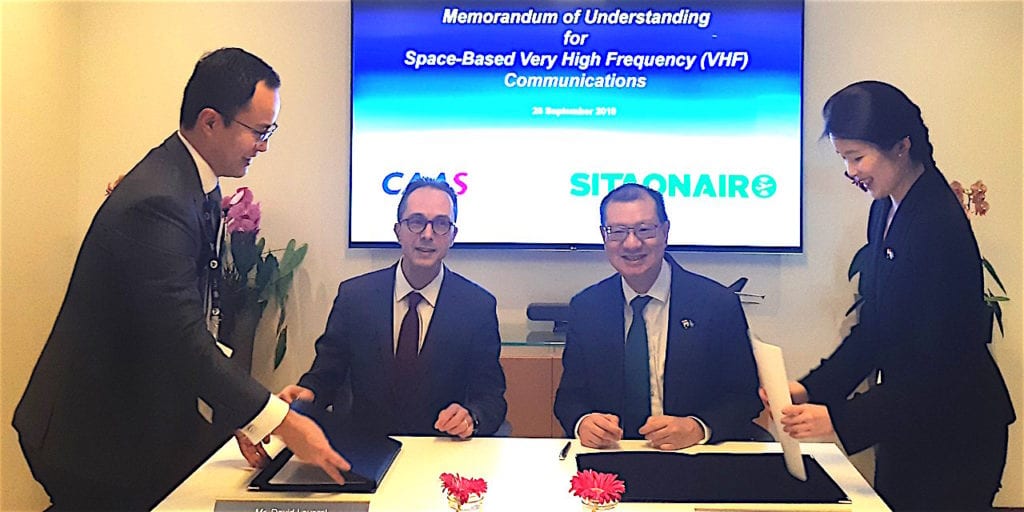
Executives from SITAONAIR and the Civil Aviation Authority of Singapore (CAAS) signed a Memorandum of Understanding to explore the potential for what they describe as a “world-first” space-based Very High Frequency (VHF) solution. Photo: SITAONAIR
Civil Aviation Authority of Singapore (CAAS) officials and air transport communications and information technology specialist SITAONAIR are researching the use of Very High Frequency (VHF) radios on high altitude drones and satellites to enable spaced-based VHF communications between air traffic controllers and airline pilots.
Officials representing CAAS and SITAONAIR say their exploration of space-based VHF is an effort to complement existing automatic dependent surveillance-broadcast (ADS-B), satellite communications (SATCOM) Voice and automatic dependent surveillance-contract/controller-pilot data link communications (ADS-C/CPDLC) technologies. Their memorandum of understanding signed September 27, 2019 starts their efforts to explore the use of space-based VHF communications for aircraft traveling in remote and oceanic airspace where VHF terrestrial infrastructure is not feasible.
“Space-based VHF voice communications, if implemented, could possibly fulfill the role of direct controller-pilot communications (DCPC) in oceanic areas or remote regions where effective communications is not available. It is envisaged to be a significant contributor to radar-like separation minima and enhancement of airspace safety, capacity, and efficiency,” Yeo Chang Nam, director of Aeronautical Telecommunications and Engineering for CAAS told Avionics International.
CAAS is already embarking on technical studies into space-based VHF in the Singapore Flight Information Region (FIR), focusing on medium earth orbit (MEO) and low earth orbit (LEO) satellites used as relay stations for voice and, if feasible, data communications. SITAONAIR’s role in the partnership will include the support of studies that enable “dual mission voice and data capability in areas that may benefit from ACARS Datalink services,” according to their description of the partnership.
SITAONAIR will also engage aviation technologies companies regarding the implementation of “High Altitude Pseudo Satellite- (HAPS)-based platforms designed to hover at 60,000ft above the earth’s surface, in the stratosphere,” and provide space-based VHF to regions that could benefit from it.
Andy Hubbard, portfolio director for SITAONAIR, said that the company does not envision the use of additional avionics equipage or alteration, bur rather in-service VHF radios could support it. The alterations would instead come to satellites.
“It is envisaged that a space-qualified VHF radio with appropriately sized power source, antenna, and command/control systems, will need to be installed on satellites, in order to provide space-based VHF services,” Hubbard said. “SITAONAIR will engage the industry to explore the implementation of unmanned aerial platforms which would hover around 60,000ft above the earth’s surface, in the stratosphere. The specifics of the technology required will be developed over the next few years, alongside regulatory work to ensure all necessary provisions are made.
SITAONAIR will find an assortment of companies to choose from when considering investing or partnering into the aviation industry’s long-lasting pursuit of HAPS technology. As an example in May 2019, California-based drone manufacturer AeroVironment and Japanese telecommunications firm SoftBang signed a partnership aimed at developing a drone capable of hovering at the Earth’s stratosphere to provide internet connectivity to individuals living in areas that have little to no access to ground or space-based infrastructure necessary to deliver the type of access to high speed internet connections that have become the norm.

Zephyr is the HAPS developed by Airbus originally as a military intelligence, surveillance and reconnaissance high altitude unmanned aircraft, it has an average operating altitude of 70,000 feet above clouds, jet streams and regular air traffic. Photo: Airbus
In December 2018, Airbus opened its first solar HAPS operating site for Zephyr, the HAPS drone that the Toulouse-based company manufacturers and describes as a solar electric unmanned aircraft that “harnesses the sun’s rays, running exclusively on solar power, above the weather and conventional air traffic; filling a capability gap complimentary to satellites.” Boeing subsidiary Aurora Flight Sciences has its own HAPS project, Odysseus, which is also designed to be solar powered with similar capabilities to Zephyr.
Most efforts at making HAPS a reality, though, have experienced technological impasses. Facebook, for example, permanently grounded its Aquila HAPS program in June 2018, although the company has continued to participate in a partnership it signed with Airbus in 2017 to research the use of HAPS for providing internet connectivity.
SITAONAIR describes the use of HAPS as an “interim solution” that would provide space-based VHF-like communications to high-traffic routes until satellites are launched that feature the type of space-qualified VHF radio described by Hubbard.
“SITAONAIR will work with CAAS to explore the conduct of relevant studies. The details are being worked out,” Hubbard said.